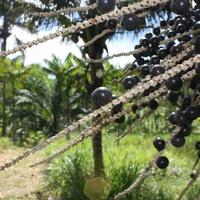Common name: Acai palm
Other common names: Cabbage palm, Manac
Description
Acai is a fruiting palm originating in South America, in the Amazon floodplains of Brazil and Peru.
It is a clumping palm, producing suckers that grow into new stems. Large clumps may have up to forty stems at different stages of development, of which only about four to eight are mature and palm-like in appearance.
Mature stems are up to 25 m (82 ft) tall, straight, round, with ringed grey bark and slender, only 10 to 15 cm (4 to 6 in) in diameter. At the top of the stem is a smooth, green crown shaft holding long palm leaves above it.
The palm leaves, or fronds, are 2 to 3 m (7 to 10 ft) long, with drooping green leaflets arranged in pairs along the length.
Flowers are creamy-white, small and insignificant, either female or male, borne close together on large, branching flower stalks. One or more flower stalks periodically emerge and grow from just below the crown shaft throughout the year.
Fertilised flowers develop into small round fruit 1 to 2 cm (0.4 to 0.8 in) in diameter. When young, they are green, turning dark purple or near black when ripe, and have thin pulp covering a sizeable hairy seed. Although produced in all seasons throughout the year, they are most abundant during the dry season.
Use
The fruit are harvested when ripe and made into a thick, dark purple juice much esteemed in its native range. The juice is prepared by stripping the ripe fruit from the bunches into a container, covering them with warm water and then allowing them to sit for about an hour or two to soften the pulp. They are then strained and macerated in a small amount of water until the pulp has separated from the seed. A second straining removes the seed, which are then discarded.
Acai fruit pulp is mainly consumed in drinks, smoothies, ice creams, sorbets and other desserts. It has a somewhat nutty flavour with a creamy-gritty texture and oily appearance.
The crownshaft, which measures about 1 m (3.3 ft) in length, is frequently harvested for its soft centre and eaten as a salad vegetable (after cooking). Known locally as 'Palmitos' or 'Palmilito' and in English as 'Palm heart', it is mainly canned for local consumption and export.

Health use
The fruit pulp is rich in antioxidants and has reasonable amounts of Vitamin A, Calcium, Phosphorus and Iron.
Climate
Grows naturally in humid to very humid tropical forests, generally frost-free areas with annual lows of 18 to 25°C, annual highs of 27 to 35°C, annual rainfall of 1500 to 5000 mm and a dry season of 3 months or less.
Growing
New plants start from seed, which usually germinate within fifty days of sowing. Seedlings are tended in a nursery with filtered or partial sun for about seven months or until they are about 50 cm (1.6 ft) tall.
Performs best on free-draining clay, loam and sand soils of an acid nature, generally with a pH of 4.5 to 6.5, and on sites with full to partial sun exposure. It has good tolerance to seasonal flooding but poor tolerance to permanently wet or water-logged soils.
Problem features
It is an aggressive coloniser of swamp forests through the dispersal of its fruit and seed by fruit-eating birds, rodents and floodwaters. In addition, its suckers grow to form dense, multi-stemmed clumps. It is recorded in Panama as having escaped cultivation, a weed of the natural environment, and as invasive, a weed class reserved for the most serious of weeds.
Where it grows
References
Books
-
Blombery, A. M. & Rodd, A. N. 1992, An informative, practical guide to palms of the world : their cultivation, care and landscape use, (Revised edition), Angus & Robertson, North Ryde, New South Wales
-
Fellows, P. 1997, Traditional foods : processing for profit, Intermediate Technology, Technical Centre for Agricultural and Rural Co-operation, London
-
Food and Agriculture Organization of the United Nations (FAO) 1986, Food and Fruit-bearing Forest Species, 3 : Examples from Latin America, FAO Forestry Paper no 44/3, Rome
-
Henderson, A., Galeano, G. and Bernal, R. 1995, Field guide to the palms of the Americas, Princeton University Press, Princeton, New Jersey
-
Janick, J., & Paull, R. E. 2008, The encyclopedia of fruit & nuts, CABI Publishing, Wallingford, Oxfordshire
-
Lorenzi, H. 2002, Brazilian trees : a guide to the identification and cultivation of Brazilian native trees. Vol. 1, 4. ed, Instituto Plantarum de Estudos da Flora, Nova Odessa, Sao Paulo
-
Rubatzky, V. E. & Yamaguchi, M. 1997, World vegetables : principles, production, and nutritive values, 2nd ed., Chapman & Hall, New York
-
Shanley, P. 2002, Tapping the green market : certification and management of non-timber forest products, Earthscan Publishing, London
-
Wallace, Alfred Russel 1989, Palm trees of the Amazon and their uses By Alfred Russel Wallace. With forty-eight plates, John Van Voorst, 1 Paternoster Row, London
Articles, Journals, Reports and Working Papers
-
Clay, J.W. and Clement, C.R. 1993, Selected species and strategies to enhance income generation from Amazonian forests, FAO Working Paper, Food and Agriculture Organisation of the United Nations (FAO), Rome




